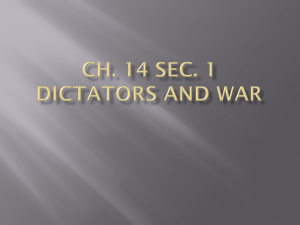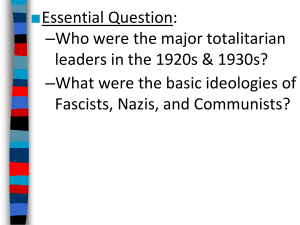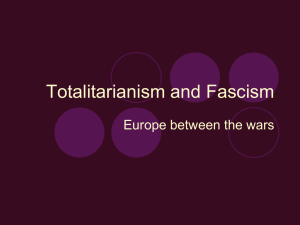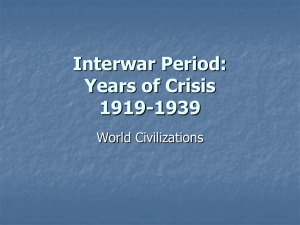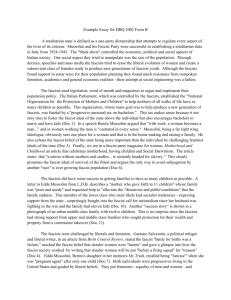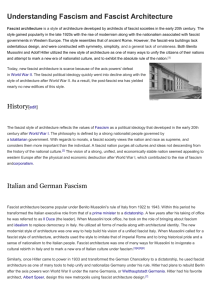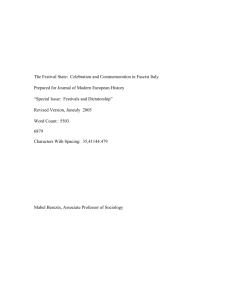Totalitarian Governments
advertisement
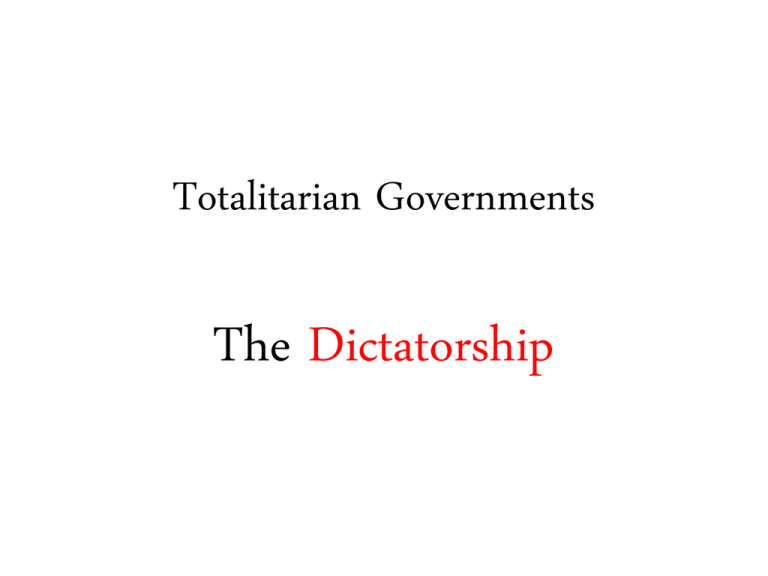
Totalitarian Governments The Dictatorship Features of the Totalitarian State 1. Single-party dictatorship 2. State control of the economy. 3. Police spies & state terrorism (against its own citizens.) 4. Strict censorship & government control of the media. 5. Use of schools & the media to indoctrinate & mobilize citizens (usually against the scapegoat.) 6. Unquestioning obedience to a single ruler. Where did the first modern totalitarian government form? The first modern totalitarian government formed in Italy in 1922 by Benito Mussolini. It was called the Fascist Party. The Fascist Party in Italy. The name comes from the fasces which was a bundle of sticks wrapped around an ax. It was a symbol of authority in ancient Rome. They rejected the democratic process in favor of violent action & terror. Fascist Tactics The Fascists Limited the press No opposition rallies or protests allowed Critics/opponents jailed or murdered Secret police The people of Italy accepted these actions because they had lost faith in the government of the king (parliamentary monarchy.) How did Mussolini come to power? Italy was plunged into social, political, & economic chaos after World War I. It didn’t get territory that it was promised as being part of the victorious allies. Peasant workers seized land from wealthy land owners. Workers went on strike or took over factories. Returning veterans faced unemployment. Rival factions had crippled the government. In 1919, Mussolini organized veterans & other discontented Italians into the Fascist party. He spoke of reviving Italian greatness. Recalled the glories of the ancient Roman Empire. He organized his supporters into “combat squads.” They wore black shirts & were nothing more than thugs. They beat up any person or group that they considered to be leftist. 1922: Mussolini announced that the Fascist party would take control of the government & restore stability. Thousands of fascist party members flooded into Rome & pressured the king (Victor Emanuel II) to make changes. To avoid civil war, the king asked Mussolini to form a government & become prime minister. Mussolini had become the head of the government without blood shed. By 1925, Mussolini & the Fascists were firmly in control of the Italian government. Mussolini became Il Duce (The Leader) It wasn’t long afterwards that Italy became an authoritarian state. Mussolini’s government would inspire Hitler & the Nazi party to do the same thing in Germany. Italy under the Fascists The Fascist government formed close ties with the business leaders of Italy. Business leaders, wealthy landowners & the lower middle class all supported the fascist policies. Business changes included – Corporate state – Representatives of business, labor, government, & the fascist party controlled industry & agriculture. – Workers could not strike. – Wages went down. The fascists were anti-democratic. Democracy led to greed, corruption, & weakness It put the individual or class interests above national goals. It destroyed feelings of community. It was more important for the citizen to serve the state. The party elite claimed to rule in national interests. Major values promoted by the Fascists Extreme nationalism Glorified action, violence, discipline (militaristic.) Blind loyalty to the state. Anti-democratic Aggressive foreign expansion or policy Based on Social Darwinism Glorification of warfare. The Individual was BAD!!! The STATE is more important than the individual. Emphasis on MANHOOD & MOTHERHOOD. Men were expected to be ruthless, selfless warriors (glorification of the military.) Women were expected to be wives & mothers All people were expected to make sacrifices for the state. Children were expected to join youth groups where they were taught to obey strict military discipline (emphasis on patriotism, athletic competition, etc.) Italian children would chant, “Mussolini is always right.” This is called the cult of personality. Glorification of the leader. Why did fascism appeal to many people? • It offered a strong national government at a time when there was political feuding & paralyzed democracy. • National pride • Charismatic leader with power & confidence. • People were willing to sacrifice their freedoms for economic or national security. Fascist Propaganda • Fascist propaganda emphasized the values of nationalism, obedience, loyalty to the leader, elimination of the common enemy. • “Believe! Obey! Fight!” • One main difference between the Fascists in Italy & the Nazis in Germany was the scapegoat. • Jews were not seen as a problem in Italy; communists & leftists were the scapegoats. Were there other fascist leaders? • Francisco Franco in Spain. • Juan Peron in Argentina (his wife was Eva of “Evita” fame.) • Adolf Hitler Francisco Franco Juan Peron Eva Peron Outcome Mussolini & his mistress were executed Italian communists on April 28, 1945. The next day the bodies of Mussolini and his mistress were found hung upside down on meat hooks in Piazzale Loreto (Milan). Franco stayed in power until his death in 1975; he named Prince Juan Carlos de Borbon as his successor in 1969. Juan Carlos became king on the death of Franco. Bodies of Mussolini, his mistress, & Italian government officials after their execution. Juan Peron was driven from power in 1955 & then returned to power in 1973-74. His wife Eva (Evita) died of cancer in 1952. She was hugely popular & inspired Andrew Lloyd Weber’s musical, “Evita.” Peron died in exile in 1974. Today’s Top 10 Dictators Sudan: Omar al-Bashir (1989) North Korea: Kim Jong-il (1994) Burma (Myanmar): Than Shwe (1992) Zimbabwe: Robert Mugabe (1980) Uzbekistan: Islam Karimov (1990) China: Hu Jintao (2002) Saudi Arabia: King Abdullah (1995) Turkmenistan: Saparmurat Niyazov (1990) Iran: Seyed Ali Khamane’i (1989) Equatorial Guinea: Teodoro Obiang Nguema (1979) Other countries with dictatorship include Libya Syria Swaziland Pakistan Eritrea Ethiopia Belarus Laos Cuba Vietnam Review--Fascism Part I: Matching Genocide Holocaust Fasces Gestapo Lebensraum Nationalism Scapegoat IL Duce Putsch Reich Review Questions--Fascism 1. What promises did fascism make that appealed to Italians? 2. Fascists in Italy wanted to pursue what national goals? 3. What ideals were Italian youths taught under the Fascist government? 4. What is considered to be a woman’s true profession under a fascist or Nazi government? 5. What slogans were men, women, & children in Italy bombarded with to support fascism? 6. Historically, what has tended to happen when nations experience continued political instability & economic depression? 7. What type of government did Mussolini create in Italy in 1922? 8. What term best describes a leader who has complete power over his nation? 9. In a nation ruled by totalitarian government, what is/are the main purpose(s) of education, art, & literature? 10. Which dictator did Mussolini inspire to create an authoritarian government in Germany? 11. What slogan did Mussolini & the Fascist party use to inspire the Italian people? 12. Which were the major reasons for Hitler’s rise to power in Germany? 13. What is the purpose of having a scapegoat under an authoritarian government? 14. What valid conclusions can be drawn from a study of the rise to power of the Nazi Party in Germany in the 1930s? 15. According to Hitler, who, besides the Jews were responsible for Germany’s problems? 16. What was the overriding concern of the U.S. during the period 1930-1935? 17. What characteristics would Italy under Mussolini & Germany under Adolf Hitler share? 18. During the 1930s, why did the Nazi Party receive support from the German people? 19. Which of the following is a valid conclusion based on a study of the Holocaust? 20. How successful was the Beer Hall Putsch? 21. What was Hitler’s belief about Germany’s loss in WW I? 22. Which incident would play a major role in forming Hitler’s anti-Semitism? 23. What government preceded Germany’s Third Reich? 24. Which situation contributed to Hitler’s rise to power in Germany after World War I? 25. Fascism in Europe during the 20s & 30s can best be described as what type of government? Listing 1. List 3 characteristics of an authoritarian government. 2. List 3 modern day dictators & the country he runs. 3. List 2 reasons why fascist were antidemocratic. 4. List 2 values promoted by Mussolini’s Fascist party. False statements 1. Under a fascist or authoritarian government, teachers are encouraged to instill in their students the respect for democracy & democratic government. 2. Most authoritarian governments come to power in a time of relative peace & stability. 3. Authoritarian governments encourage individualism & a spirit of questioning, especially concerning the policies of the government. 4. The spread of democratic principles has virtually destroyed all authoritarian style governments. 5. The main supporters of an authoritarian government would come from the liberal professionals who believe a strong, national government is important. • Under a fascist government, teachers are encouraged to instill in their students the respect for democracy & democratic government. RESPONSE: A fascist government thinks that democracy promotes weakness. Democracy promotes individualism & the fascists believe that the state is more important than the individual. Teachers must promote obedience to the state & conformity.




